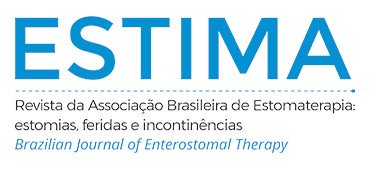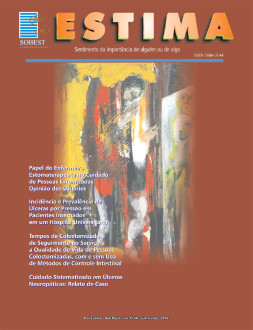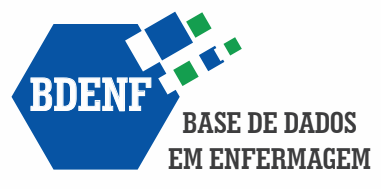Time since Colostomy, Follow-up Time at the Health Center and Quality of Life of Colostomy Patients Using or not Using Methods of Bowel Control
Abstract
Patients experience changes in lifestyle during the period of time following colostomy when they have to adapt to their new condition, which is considered necessary for their rehabilitation. However, no study on the impact of colostomy in the quality of life (QOL) of patients was found in the literature. The aim of this study was to evaluate whether time since colostomy and follow-up time at the Health Center had an impact on the QOL of colostomy patients using or not using methods of bowel control. This was a comparative cross-sectional study. The sample consisted of colostomy patients seen in a health center, who were divided into two groups of 50 individuals each: those using bowel control methods (BCM group) and those not using methods of bowel control [no control method (NCM) group]. The World Health Organization Quality of Life Instrument, Short Form (WHOQOL-BREF) was administered to all patients as an interview. The mean time since colostomy was 66.64 months (SD = 46.39) for the BCM group and 32.30 months (SD = 37.81) for the NCM group, and the mean follow-up time was 56.44 months (SD = 41.7) for the BCM group and 27.12 months (SD = 32.09) for the NBC group, with significant differences between groups (p <0.001). The longer the length of device use the higher was the mean QOL score in the physical domain. Also, the longer the time since colostomy and follow-up time the higher were the mean QOL scores in the physical and psychological domains and the overall QOL score. This indirectly reflects the importance of the health team in the rehabilitation of colostomy patients using or not using methods of bowel control.
Downloads
Metrics
References
Barbutti RCS, Póvoas da Silva MC, Abreu MAL. Ostomia, uma difícil adaptação. Rev SBPH. 2008; 11(2):27-39.
Menezes MMPNC. Satisfação conjugal, autoestima e imagem corporal em indivíduos ostomizados [tese]. Portugal: Universidade de Lisboa, Faculdade de Psicologia e Ciências da Educação; 2008.
Cassero PAS, Aguiar E. Percepções emocionais influenciadas por uma ostomia. Rev Saud Pesq. 2009;2(2):23-27.
Santos CSVB. Saúde e qualidade de vida da pessoa portadora de ostomia de eliminação [tese]. Porto: Universidade do Porto, Faculdade de Psicologia e Ciências da Educação; 1999.
Cesaretti IUR, Santos VLCG, Vianna LAC. Influência do tempo de colostomizado e de acompanhamento no serviço sobre a qualidade de vida de pessoas colostomizadas [resumo]. In: 11° Congresso Brasileiro de Estomaterapia; 2011; Porto Alegre. Anais. Porto Alegre: SOBEST; 2011.
Sousa CF, Brito DC, Branco MZPC. Depois da colostomia… vivências das pessoas portadoras. Enferm Foco 2012;3(1):12-15.
Rey JG. Sistemas continentes de colostomías (I): sistema de irrigación. Rev Rol Enferm. 1994; 17(195):69-72.
Rey JG. Sistemas continentes de colostomías (II): el obturador. Rev Rol Enferm. 1994;17(194):71-74.
Santos VLCG, Cesaretti IUR, Ribeiro AM. Métodos de “controle” intestinal em ostomizados: auto-irrigação e sistema oclusor. In: Santos VLCG, Cesaretti IUR, org. Assistência em Estomaterapia: cuidando do ostomizado. São Paulo: Atheneu; 2000. p. 245-262.
Cesaretti IUR, Santos VCG, Vianna LAC. Qualidade de vida de pessoas colostomizadas, com e sem o uso de métodos de controle intestinal. Rev Bras Enferm. 2010;63(1):16-21.
Bechara RN, Bechara MS, Bechara CS et al. Abordagem multidisciplinar do ostomizado. Rev Bras Coloproct. 2005;25(2):146-149.
Castillo P, Coto MV, Gil L, et al. Irrigación de la colostomia. Rev Rol Enferm. 2000;146:59-61.
Cohen A, Zierstein R. Drawing your body image. World Council Enterostom Ther J. 1995;15(3):30-31.
Harisi R, Bodoky G, Borsodi M et al. Rectal cancer therapy: decision making on basis of quality of life? Zentralbl Chir. 2004;129:139-148.
Grumann MM, Noack EM, Hoffmann IA, Schlag PM. Comparison of quality of life in patients undergoing abdominoperineal resection for rectal cancer. Ann Surg. 2001;233(2):149-156.
Piwonka MA, Merino JM. A multidimensional modeling of predictors influencing the adjustment to a colostomy. J Wound Ostomy Continence Nurs. 1999;26(6):298-305.
Turnbull G, Colwell JC, Erwin-Toth P. Quality of life: pre, post and beyond ostomy surgery. Ostomy Wound Manage. 2004; 50(7A Suppl):1-12.
Trentini M, Pacheco MAB, Martins ML, et al. Vivendo com um ostoma: um estudo preliminar. Rev Gaúcha de Enferm. 1992;13(2):22-28.
Ito N, Tanaka M, Kazuma K. Health-related quality of life among persons living in Japan with a permanent colostomy. J Wound Ostomy Continence Nurs. 2005;32(3):179-183.
Woodhouse F. Colostomy irrigation: are you offering it enough? Br J Nurs. 2005;14(16 Sup):14-15.
Rogenski NMB, Baptista CMC, Rogenski KE. Auto-irrigação: avaliação de resultados. Rev Esc Enf USP 1999; 33(N. especial):50-54.
Rauch P, Miny J, Conroy T, et al. Quality of life among disease-free survivors of rectal cancer. J Clin Oncol. 2004;22:354-360.
Camilleri-Brennan J, Steele RJC. Objective assessment of quality of life following panproctocolectomy and ileostomy for ulcerative colitis. Ann R Coll Surg Engl. 2001;83(5):321-324.
Marquis P, Marrel A, Jambon B. Quality of life in patients with stomas: the Montreux Study. Ostomy Wound Manage. 2003;49(2):48-55.
Cesaretti IUR. Qualidade de vida de pessoas colostomizadas, com e sem o uso de métodos de controle intestinal [tese]. São Paulo: Universidade Federal de São Paulo, Departamento de Enfermagem; 2008.
Fleck MPA, Louzada S, Xavier M, et al. Aplicação da versão em português do instrumento de avaliação abreviado de qualidade de vida WHOQoL-bref. Rev Saúde Públ. 2000;34(2):178-183.
Organização Mundial de Saúde. Divisão de Saúde Mental. Grupo WHOQoL. Grupo de Estudos em Qualidade de Vida. Versão em português dos instrumentos de avaliação de qualidade de vida (WHOQoL): 1998. Coordenação de Marcelo Pio de Almeida Fleck. [Texto na Internet]. Porto Alegre: Universidade Federal do Rio Grande do Sul; 1998. [citado 2006 Nov 9]. Disponível em <http://www.ufrgs.br/psiq/whoqol1.html>.
Minayo MCS, Hartz ZMA, Buss PM. Qualidade de vida e saúde: um debate necessário. Ciênc Saúde Colet. 2000; 5(1):7-18.
Duarte PS, Ciconelli RM. Instrumentos para a avaliação da qualidade de vida: genéricos e específicos. In: Diniz DP, Schor N, org. Guias de medicina ambulatorial e hospitalar UNIFESP – Escola Paulista de Medicina: Qualidade de vida. São Paulo: Manole; 2006. p. 11-18.
McDowell I, Newell C. Measuring health: guide to rating scales and questionnaires. 2nd Ed. New York: Oxford University Press; 1996.
Levin J, Fox JA. Estatística para ciências humanas. 9ª ed. São Paulo: Prentice Hall; 2004.
Orsted HL. Health Related Quality of Life for the person with an ostomy. World Council Enterostom Ther J. 2007;27(1):34-37.



























